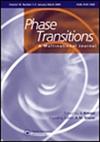RE11Co4ln9(RE = Tb,Er)
IF 1.4
4区 材料科学
Q3 CRYSTALLOGRAPHY
引用次数: 0
摘要
用磁强法研究了稀土Co in (RE = Tb, Er)的磁热效应与温度和外加磁场的关系。在磁通量密度变化()0 ~ 9 T时,Tb Co In在47.4 K时的最大磁熵变化()为5.51 J kg K, Er Co In在12.3 K时的最大磁熵变化()为14.28 J kg K,而RE = Tb和Er的3 K跨度温度平均熵变化(TEC)分别为5.50和14.14 J kg K。Tb Co in的相对冷却功率(RCP)和制冷剂容量(RC)分别为522.1和391.2 J kg, Er Co in的相对冷却功率(RCP)和制冷剂容量(RC)分别为605.2和463.1 J kg。本文章由计算机程序翻译,如有差异,请以英文原文为准。
Magnetocaloric performance of RE11Co4ln9 (RE = Tb, Er)
ABSTRACT The magnetocaloric effect in RE Co In (RE = Tb, Er) has been studied by means of magnetometric measurements in the function of temperature and applied magnetic field. The maximum magnetic entropy change ( ) at magnetic flux density change ( ) 0–9 T has been determined to be 5.51 J kg K at 47.4 K for Tb Co In and 14.28 J kg K at 12.3 K for Er Co In , while temperature averaged entropy change (TEC) with 3 K span equals 5.50 and 14.14 J kg K for RE = Tb and Er, respectively. The relative cooling power (RCP) and refrigerant capacity (RC) equal respectively 522.1 and 391.2 J kg in Tb Co In and 605.2 and 463.1 J kg in Er Co In .
求助全文
通过发布文献求助,成功后即可免费获取论文全文。
去求助
来源期刊

Phase Transitions
物理-晶体学
CiteScore
3.00
自引率
6.20%
发文量
61
审稿时长
1.4 months
期刊介绍:
Phase Transitions is the only journal devoted exclusively to this important subject. It provides a focus for papers on most aspects of phase transitions in condensed matter. Although emphasis is placed primarily on experimental work, theoretical papers are welcome if they have some bearing on experimental results. The areas of interest include:
-structural phase transitions (ferroelectric, ferroelastic, multiferroic, order-disorder, Jahn-Teller, etc.) under a range of external parameters (temperature, pressure, strain, electric/magnetic fields, etc.)
-geophysical phase transitions
-metal-insulator phase transitions
-superconducting and superfluid transitions
-magnetic phase transitions
-critical phenomena and physical properties at phase transitions
-liquid crystals
-technological applications of phase transitions
-quantum phase transitions
Phase Transitions publishes both research papers and invited articles devoted to special topics. Major review papers are particularly welcome. A further emphasis of the journal is the publication of a selected number of small workshops, which are at the forefront of their field.
 求助内容:
求助内容: 应助结果提醒方式:
应助结果提醒方式:


